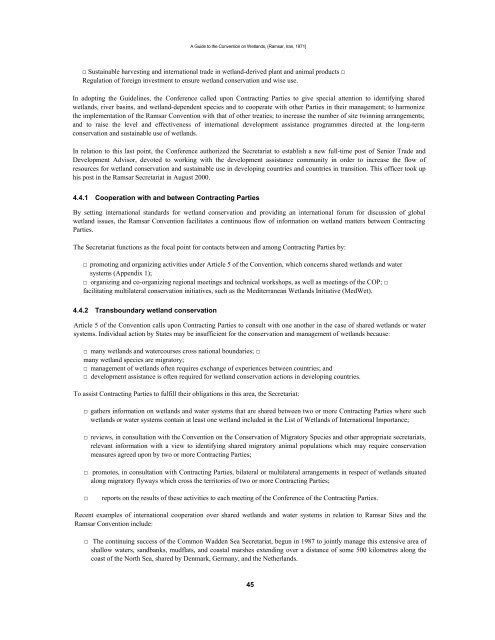The Ramsar Convention Manual.pdf
The Ramsar Convention Manual.pdf
The Ramsar Convention Manual.pdf
Create successful ePaper yourself
Turn your PDF publications into a flip-book with our unique Google optimized e-Paper software.
A Guide to the <strong>Convention</strong> on Wetlands, (<strong>Ramsar</strong>, Iran, 1971]<br />
□ Sustainable harvesting and international trade in wetland-derived plant and animal products □<br />
Regulation of foreign investment to ensure wetland conservation and wise use.<br />
In adopting the Guidelines, the Conference called upon Contracting Parties to give special attention to identifying shared<br />
wetlands, river basins, and wetland-dependent species and to cooperate with other Parties in their management; to harmonize<br />
the implementation of the <strong>Ramsar</strong> <strong>Convention</strong> with that of other treaties; to increase the number of site twinning arrangements;<br />
and to raise the level and effectiveness of international development assistance programmes directed at the long-term<br />
conservation and sustainable use of wetlands.<br />
In relation to this last point, the Conference authorized the Secretariat to establish a new full-time post of Senior Trade and<br />
Development Advisor, devoted to working with the development assistance community in order to increase the flow of<br />
resources for wetland conservation and sustainable use in developing countries and countries in transition. This officer took up<br />
his post in the <strong>Ramsar</strong> Secretariat in August 2000.<br />
4.4.1 Cooperation with and between Contracting Parties<br />
By setting international standards for wetland conservation and providing an international forum for discussion of global<br />
wetland issues, the <strong>Ramsar</strong> <strong>Convention</strong> facilitates a continuous flow of information on wetland matters between Contracting<br />
Parties.<br />
<strong>The</strong> Secretariat functions as the focal point for contacts between and among Contracting Parties by:<br />
□ promoting and organizing activities under Article 5 of the <strong>Convention</strong>, which concerns shared wetlands and water<br />
systems (Appendix 1);<br />
□ organizing and co-organizing regional meetings and technical workshops, as well as meetings of the COP; □<br />
facilitating multilateral conservation initiatives, such as the Mediterranean Wetlands Initiative (MedWet).<br />
4.4.2 Transboundary wetland conservation<br />
Article 5 of the <strong>Convention</strong> calls upon Contracting Parties to consult with one another in the case of shared wetlands or water<br />
systems. Individual action by States may be insufficient for the conservation and management of wetlands because:<br />
□ many wetlands and watercourses cross national boundaries; □<br />
many wetland species are migratory;<br />
□ management of wetlands often requires exchange of experiences between countries; and<br />
□ development assistance is often required for wetland conservation actions in developing countries.<br />
To assist Contracting Parties to fulfill their obligations in this area, the Secretariat:<br />
□ gathers information on wetlands and water systems that are shared between two or more Contracting Parties where such<br />
wetlands or water systems contain at least one wetland included in the List of Wetlands of International Importance;<br />
□ reviews, in consultation with the <strong>Convention</strong> on the Conservation of Migratory Species and other appropriate secretariats,<br />
relevant information with a view to identifying shared migratory animal populations which may require conservation<br />
measures agreed upon by two or more Contracting Parties;<br />
□ promotes, in consultation with Contracting Parties, bilateral or multilateral arrangements in respect of wetlands situated<br />
along migratory flyways which cross the territories of two or more Contracting Parties;<br />
□<br />
reports on the results of these activities to each meeting of the Conference of the Contracting Parties.<br />
Recent examples of international cooperation over shared wetlands and water systems in relation to <strong>Ramsar</strong> Sites and the<br />
<strong>Ramsar</strong> <strong>Convention</strong> include:<br />
□ <strong>The</strong> continuing success of the Common Wadden Sea Secretariat, begun in 1987 to jointly manage this extensive area of<br />
shallow waters, sandbanks, mudflats, and coastal marshes extending over a distance of some 500 kilometres along the<br />
coast of the North Sea, shared by Denmark, Germany, and the Netherlands.<br />
45












